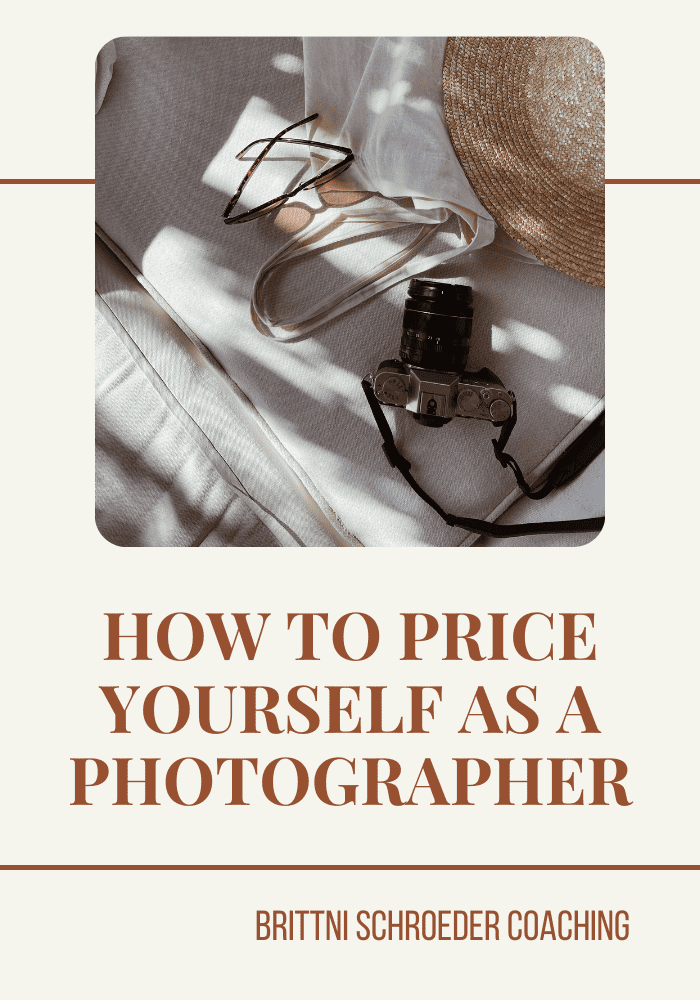brittni schroeder
BLOG
Brittni Schroeder Coaching
HOW TO PRICE YOURSELF
AS A PHOTOGRAPHER

Pricing can be a tricky topic. As entrepreneurs, we tend to both highly value and undervalue our work simultaneously. We know the time and financial sacrifice it took to hone our craft and establish a business, yet we struggle with recognizing our value and having the confidence to follow through with pricing that reflects that value. You need to learn how to price yourself as a photographer.
The first step in a successful pricing strategy is to set a financial goal. How much do you want or need to make annually? The rest is simple math. Once you determine your annual income goal, decide how often you want to work.
Example 1: I want to work with one client a week and take off seven weeks a year. That would mean working with 45 clients a year. If my annual income goal is $45,000, I need to charge $1000 per client.
$45,000/45 = $1000
Example 2: I want to work with four clients a week and take seven weeks off a year. That would mean working with 180 clients a year (or 45 a month). If my annual income goal is $150,000, I need to charge around $835 per client.
$150,000/180 = $835
As you play around with the formula, you may realize you want to charge more and work less. Once you have finalized your number and come up with the amount you need to charge each client to reach your goal, you have just determined the price of your minimum package.
WEBSITE PRICING
There are conflicting opinions on whether to display your pricing on your website. Your industry may help you determine which route is best. When I was primarily a photographer, my website clearly stated that my packages started at $750. This transparency attracted ideal clients and repelled those turned off by the price. Once a client inquired about booking a session, I sent them my magazine. I talked about my work, what to wear, what to expect, etc. I then revealed my full pricing close to the end. I wanted them to be sold on my process and understand my value before they looked at the detailed prices.
In my coaching business I don’t list my pricing or packages online. I do a consult with each client. I explore their needs and underscore the value of what I am offering. At the end of the call, I tell them what it costs to work with me.
The goal is to sell your clients on your service or product first. You want them to decide that they want to use you long before they see your prices. Then they will figure out a way to pay what you are worth because they value what you offer. These are your ideal clients.
CREATING PACKAGES
Clients prefer packages over hourly pricing. Entrepreneurship requires flexibility. One hour may turn into five hours and you don’t want to chase down money from your clients or leave clients annoyed because they have to pay more than anticipated. Package pricing implies expertise—that you are not just about the money but about providing top notch service regardless of time spent. Sometimes it is necessary to charge an hourly rate for events, but try to pair your hourly rate with products and services to ensure your client feels like they are getting a great value.
When creating package pricing, you want to start by listing out everything your ideal client needs.
Consider the following:
Does your client need help trying to figure out what to wear?
How long will it take to do a session?
How much time will it take to edit their session?
How long will it take for their ordering session, packaging orders, and delivery?
What is the cost of products?
Look at everything your ideal client could possibly need or ask for during a project and bundle it together (within reason) into a complete package. Don’t nickel and dime your clients. Remember to always under-promise and over-deliver. A good rule of thumb is if it is going to take less than 30 minutes of your time, do it. If it is going to cost you less than $20, do it.
What to Include in Your Packages?
Have you heard of paralysis by analysis? When we are given too many choices we become paralyzed and don’t know what to choose and so end up choosing nothing. Give your clients 3-4 different package options. Pick 2-3 high end products that you want to sell and put them in your packages. Remember that you can always include an à la carte option in your pricing.
Pinpoint your bestselling products and put those in your top and middle-priced packages. My two highest selling products were digital images and albums. Those two products are not in my lowest package.
To simplify, price all your prints at the same price. For example, 8×10 or smaller is considered a gift print. Include 5 gift prints in your all your packages. They will pay the same for an 8×10 as they do a 4×6. This will also help push them towards purchasing the digitals so they can print their own images.
Price your highest package at a ridiculous amount. This does two things. It makes for a really awesome day when someone ends up purchasing that collection, but it also pushes clients toward your middle package.
Security Deposit/Sitting Fee
A security deposit is just that—security. It secures that spot for your client, and also gives you a guaranteed amount made before you even begin. Having a larger security deposit serves a few purposes. First, it will help you attract your ideal client. Asking for a larger amount upfront ensures that your client can afford to pay for your services and also when it comes time to order they have idea what to expect. Secondly, if part of the security deposit goes towards their order they will be willing to spend more money because they won’t have to come up with as much at their ordering session. Lastly, if on occasion if you have someone who doesn’t show up or doesn’t place an order, you are not out the time you spent working with them. Years ago I raised my security deposit. I worried I would lose business, but I didn’t and it has been one of the best things I have done.
How to Price Products
When pricing high-end products ($100 or more), I suggest charging at least three times what you pay out of pocket. The reason? On occasion a client might not double check the file name or there may be a picture that needs a touch-up edit and you will have to reorder. I am not saying IF this happens, I am saying WHEN it happens, because it will. You do not want to go into the negative when you have to replace a product. Charging three times the base product cost ensures you will still make a profit even if you have to reprint.
DIGITALS
If you sell digitals—and you can assume most photographers do—refrain from selling individual files. Sell all the digitals or none. Selling individual files or even 5, 10, or 20 will bring your sells down drastically. Most clients will want the digitals. If you give them options, clients will narrow down their five favorites and convince themselves they don’t need the rest of the images. Remember: once you give the digitals, clients can print on demand and won’t buy prints or products because they know they can them cheaper elsewhere, regardless of the quality. Your digitals should be your highest product listed. Price them extremely high to push them towards buying a package that includes more products.
VERBIAGE
Use phrases such as “most popular” or “biggest savings” to entice your clients to buy your higher collections. You want your clients to know that you are saving them money. Figure out what the package would cost if they bought everything à la carte and let them know what they will save. Let your clients know what others are purchasing and why. Clients like to be told what to do or what is popular. This is one less choice they have to make. We often reason that if so many others are doing it, it must be the best decision.
À La Carte
Assign high prices to everything in your à la carte. This will push your clients towards your packages and get them to spend more. Your clients will realize they get more for their money when they purchase a package and in turn that will increase your sales.
Pricing can often be one of our biggest points of confusion. We know we are worth more, but don’t have the confidence to charge that amount. Do the math first and then work on your mindset. Once you have learned those tools you will know how to price yourself as a photographer. Learn to understand and embrace your value, because if you don’t value your time and work, your clients won’t either.
